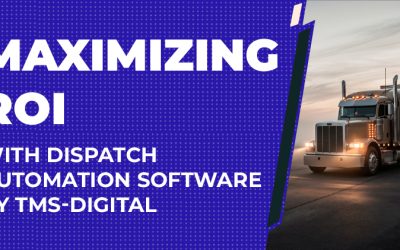
Transportation Management System (TMS) Dispatch is essential to efficient fleet management, particularly for transportation and logistics companies. TMS dispatch systems help streamline the dispatch process by automating and optimizing the assignment of loads to drivers and vehicles. This comprehensive guide aims to thoroughly understand TMS dispatch by covering its definition, key features, benefits, and challenges. We will also provide insights on implementing TMS dispatch in your fleet and the best practices for achieving successful outcomes.
By the end of this guide, you will better understand TMS dispatch and its role in improving your fleet’s efficiency, productivity, and profitability.
What is Dispatch?
Dispatch is a crucial function of Transportation Management Systems (TMS) that enables transportation and logistics companies to efficiently manage their fleets by automating and optimizing the assignment of loads to drivers and vehicles. TMS dispatch systems use advanced algorithms to consider the weight, volume, and priority of shipments, available drivers and their location, vehicle capacity and restrictions, and delivery timelines to assign the most suitable driver and vehicle to each load.
In addition to load assignment, dispatch systems provide dispatchers with real-time visibility and tracking of drivers and vehicles, allowing them to adjust assignments and schedules as needed. This real-time visibility also enables dispatchers to communicate with drivers and customers about delivery status, potential delays, and any changes in delivery instructions.
Dispatch systems can be customized to meet a fleet’s specific needs. They can integrate with other systems, such as transportation planning, warehouse management, and customer relationship management, to provide a seamless end-to-end solution for transportation and logistics companies.
Benefits of Dispatch
Dispatch offers many benefits to transportation and logistics companies, including:
Improved efficiency and productivity: Dispatch systems automate and optimize the dispatch process, which reduces manual work and increases productivity. Dispatchers can quickly assign loads to drivers and vehicles, and drivers can receive and update their assignments in real time. This results in faster load delivery, reduced wait times, and improved driver utilization.
Cost savings: It helps companies reduce costs by optimizing the use of their resources. Dispatchers can assign loads based on the most efficient route, load combination, and vehicle capacity, which minimizes the number of trips and reduces fuel consumption. TMS dispatch can also help companies avoid fines and penalties for non-compliance with regulations, which can be costly.
Better customer service: It provides real-time visibility into load status, allowing dispatchers to proactively communicate with customers about potential delays or changes in delivery instructions. This improves customer satisfaction and loyalty.
Real-time visibility and tracking: These systems provide dispatchers and managers with real-time visibility into the location and status of drivers and vehicles, which allows them to monitor load progress and adjust assignments and schedules as needed. This visibility also helps companies proactively address any issues during delivery.
Increased safety and compliance: Dispatch systems can help companies ensure that their drivers and vehicles comply with safety and regulatory requirements. Dispatchers can assign loads based on driver and vehicle qualifications, restrictions, and schedules, which helps companies avoid non-compliance fines and penalties. The real-time visibility also allows companies to monitor driver behavior and take corrective action if needed.
Key Features of TMS Dispatch Software
TMS dispatch software offers a range of features that help transportation and logistics companies automate and optimize their dispatch process. Some of the critical features of TMS dispatch software include:
Dispatch automation: TMS dispatch software automates the load assignment process, allowing dispatchers to assign loads to the most suitable driver and vehicle quickly. Dispatchers can also use automation to send load information to drivers and receive real-time updates on load status.
Route optimization and planning: TMS dispatch software can optimize the most efficient route for drivers based on traffic, road conditions, and delivery time windows. This helps reduce travel time and fuel costs and improves on-time delivery performance.
Load management and scheduling: TMS dispatch software can manage loads and schedule deliveries based on driver availability, vehicle capacity, and customer requirements. Dispatchers can also use load management features to consolidate loads, which reduces the number of trips and maximizes the use of resources.
Communication and collaboration tools: TMS dispatch software offers a range of communication and collaboration tools that enable dispatchers to communicate with drivers and customers in real time. These tools can include mobile applications, messaging, and notifications that provide updates on load status, delivery times, and any changes in instructions.
Reporting and analytics: TMS dispatch software provides a range of reporting and analytics features that enable companies to track and measure key performance indicators such as on-time delivery, driver utilization, and load optimization. These features help companies identify areas for improvement and make data-driven decisions to optimize their dispatch operations.
 Challenges and Solutions in Dispatch
Challenges and Solutions in Dispatch
While dispatch offers many benefits to transportation and logistics companies, there are also some challenges that companies may face when implementing and using dispatch software. Here are some of the most common challenges and solutions:
Data quality: Dispatch software relies on accurate and up-to-date data to make informed decisions about load assignment and route optimization. Data quality, such as incorrect or missing information about drivers, vehicles, and loads, can lead to errors and delays in the dispatch process.
Solution: Companies can address data quality issues by implementing data governance policies, conducting regular data quality checks, and investing in data management tools.
Driver adoption: Drivers may refrain from using new technology, leading to low adoption rates and limited visibility into load status.
Solution: Companies can encourage driver adoption by providing training and support, highlighting the benefits of the technology, and involving drivers in the selection and implementation process.
Integration with other systems: Dispatch software must often integrate with other systems, such as transportation planning, warehouse management, and customer relationship management, to provide a seamless end-to-end solution. However, integration can be challenging due to differences in data formats and system requirements.
Solution: Companies can work with their technology vendors and IT teams to ensure systems are properly integrated, and data is transferred accurately.
Compliance and regulatory requirements: The software must comply with various conditions such as hours-of-service rules, weight limits, and hazardous materials restrictions. Failure to comply can result in fines and penalties.
Solution: Companies can ensure compliance by configuring the software to account for regulatory requirements, providing training and support to drivers, and monitoring compliance through the software.
Cost: Implementing TMS dispatch software can be expensive, especially for small to medium-sized businesses.
Solution: Companies can manage costs by selecting a solution that fits their budget and offers the needed features, implementing the solution in phases, and working with vendors to negotiate prices.
Implementing TMS Dispatch in Your Fleet
Implementing a TMS dispatch system in your fleet can be complex, but it can deliver significant benefits in improved efficiency, productivity, and cost savings. Here are some steps to consider when implementing TMS dispatch in your fleet:
Identify your goals and requirements: The first step in implementing TMS dispatch is to identify your goals and needs. This includes understanding your current dispatch process, identifying areas for improvement, and defining the specific features and functionality you require from a TMS dispatch system.
Evaluate TMS dispatch solutions: Once you have identified your goals and requirements, you can evaluate TMS dispatch solutions that meet your needs. This can involve researching vendors, attending demos, and reviewing customer references to assess the capabilities and reliability of different solutions.
Plan for integration: When implementing TMS dispatch, it’s essential to consider how it will integrate with other systems, such as transportation planning, warehouse management, and customer relationship management. This may involve customizing integrations or developing new ones to ensure seamless data flow and avoid duplication of effort.
Pilot the system: Before rolling out TMS dispatch to your entire fleet, piloting the system with a small group of users is important. This allows you to test the system’s capabilities, identify issues, and adjust as needed.
Train users: Once you have successfully piloted the system, you must train your users to use the t dispatch system effectively. This includes training on the system’s specific features and functionality and best practices for dispatch operations.
Monitor and optimize: Finally, it’s important to monitor the performance of the TMS dispatch system and make adjustments as needed to optimize performance. This may involve changing the system configuration or processes or providing additional training or support to users.
Conclusion
TMS dispatch software is a powerful solution for transportation and logistics companies looking to streamline their dispatch operations and improve efficiency. From automation and route optimization to load management and reporting, TMS dispatch software offers a range of features that can help companies reduce costs, enhance customer satisfaction, and gain a competitive advantage in the market.
Suppose you’re looking for the right TMS dispatch software for your business. In that case, TMS-Digital is a leading provider that offers a comprehensive suite of features and capabilities to help you streamline your dispatch operations. With TMS-Digital, you can automate your dispatch process, optimize your routes, manage your loads, and communicate with drivers and customers in real time. You can also gain insights into your performance through advanced reporting and analytics features, helping you identify areas for improvement and make data-driven decisions.
So why wait? Contact TMS-Digital today to learn more about how our TMS dispatch software can help you take your dispatch operations to the next level and drive business success.









